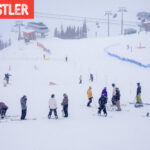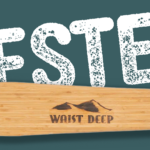
I wasn’t of working age when the Ski Canada Journal, as we were once called, started rolling off the presses 40 years ago. I was busy taping Jean-Claude Killy, Nancy Greene and “Keep those tips up” Lange posters to my wall—and pestering my dad (unsuccessfully) for a pair of red-white-’n’-blue K2 Comp Fours, Nordica Banana boots and a White Stag jacket.
I don’t remember there even being a Canadian ski magazine, or at least not until the 1980s when my university housemates and I filled out a “Bill Me Later” subscription card under the name of “Robbie Dawg.” (The shaggy mutt I’d saved from the Kingston pound wasn’t much of a reader, so I got his copies.)
It was more out of actual interest than guilt from unpaid magazine invoices that I kept reading Ski Canada after I graduated and got my first job in a geosciences lab. Despite my poring over travel stories, new gear, competition and gossip, it never occurred to me that with all the years I’d spent in science, I was heading down the wrong run on the trail map.
I’m still not sure I believe in fate, but I somehow fell into magazine journalism. And I know it sounds corny, but I knew the first day I was where I belonged. That wacky Maclean-Hunter office was home to the personalities of Ski Canada, a sister magazine of the equally noisy magazine Canadian Yachting (where I’d somehow hopped on board).
Two years later, the managing editor’s job at Ski Canada came available and I jumped ship. Publisher Paul Green, production editor Anne Slade and western manager David Harkley all welcomed me. After Maclean-Hunter sold the magazine, I had a few years writing for other magazines and the Canadian Press news wire in the early ’90s, and eventually returned home to Ski Canada—and we’re all still together today.
Of course, if we were all physically in the same office, we’d have killed each other long ago, but Ski Canada has been a virtual office for more than 20 years. I often wonder how we did it before the internet with writers, photographers, editors, designers, ad sales reps, circulation managers, lounge singers and so on spread out across the country and beyond.
Indeed, my early memories of magazine production seem so incredibly archaic, as I think back in nostalgic haze. I was only in the magazine gig for a year or so before the arrival of desktop publishing, but it was a fascinating learning curve of a year.
It’s a completely different writing skill when deleting, cutting and pasting, spellcheck, Microsoft thesaurus and so on doesn’t exist. But at least I was a lucky one with an electric typewriter in my office. In those days, hard copy from writers was mailed to the magazine, then marked up by a series of editors’ red pens with Greek-like editing symbols before being sent away to typesetters. These moles appeared to live in the basement, re-inputting all the work that had already been typed once—and outputting from a car-sized printer we called Bullwinkle. (In those days, our cast of thousands included a woman, also in the basement, whose job it was to operate the company’s fax machine. As I recall, when she was pregnant, she would wear a lead apron all day—and fall asleep a lot.)
In any event, repeated attempts back and forth with the typesetters to clean the copy of errors and changes eventually resulted in the delivery of columns of words on long, plastic-feeling repro paper. This in turn was run through a hot-wax machine, which applied a sticky coating for rows of paste-up artists to lay onto big cardboard boards. Photos had to be added (some pages allowed colour, the majority were only black and white). Mistakes still made their way through to the final stages and were corrected with surgical scalpels as individual words or letters had to be literally cut out of stories and replaced with correct ones.
After the paste-up boards had been photographed by titanic cameras and turned into enormous yellow, blue, magenta and black pieces of film, everything went to the strippers. This highly paid group of chain-smoking journeymen spent their days bent over tables with large magnifying lenses ensuring each colour layer of film from our Player’s Light and Crown Royal advertisements matched precisely on top of one another. With the arrival of computers and desktop publishing systems, their jobs vanished like a meteorite had hit the industry.
I remember the office’s first computer—a “word-processor.” The letters and numbers on the screen eerily glowed green and black, and it was on wheels to make it a “portable” computer. For the longest time I didn’t know how to turn it off—so I would just pull the plug from the wall.
As I’m writing this, it’s after 2:00 a.m. and Art Director Norm and I are just wrapping up another issue. Nothing like a deadline to get things done. Late nights at the end of a production cycle are one constant that hasn’t changed for most in the magazine industry. But they’re a small price to pay for skiing with some amazing people in some pretty amazing places. ❄



